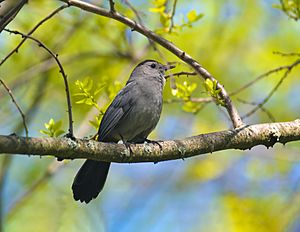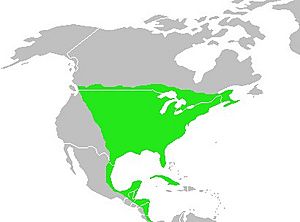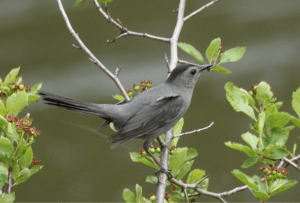Gray catbird facts for kids
Quick facts for kids Gray catbird |
|
|---|---|
 |
|
| Adult at the Arnold Arboretum, Massachusetts, United States |
|
| Conservation status | |
| Scientific classification | |
| Genus: |
Dumetella
|
| Species: |
carolinensis
|
 |
|
| Summer and winter range | |
| Synonyms | |
|
Genus:
|
|
The gray catbird (Dumetella carolinensis), also spelled grey catbird, is a medium-sized bird found in North and Central America. It belongs to the mimid family, which includes birds known for mimicking sounds. This bird is the only member of its special group, called Dumetella. Sometimes, people call it the slate-colored mockingbird because of its color.
Contents
About the Name
The name Dumetella comes from a Latin word meaning "small thornbush-dweller." This name fits because the bird often sings while hidden in thick bushes. The second part of its scientific name, carolinensis, means "from the Carolinas," where it was first studied.
The famous scientist Carl Linnaeus first described this bird in 1766. He originally named it Muscicapa carolinensis, thinking it was a type of Old World flycatcher. This was because of its plain gray color, which is different from other birds in its family.
Another name, felivox, means "cat voice." This name was given because of the bird's unique cat-like call.
What They Look Like
Gray catbirds are mostly plain gray all over. The top of their head is a bit darker. Under their tail, their feathers are a rust color. Their wing and tail feathers are black, sometimes with white edges. Their thin beak, eyes, legs, and feet are also black.
Adult catbirds usually weigh between 23 and 56 grams (about 0.8 to 2 ounces). They are about 20.5 to 24 centimeters (8 to 9.5 inches) long. Their wings can spread from 22 to 30 centimeters (8.5 to 12 inches) wide. It's hard to tell male and female catbirds apart just by looking at them. Young catbirds are even plainer in color, with yellowish undertail feathers.
What They Eat
About half of a gray catbird's diet is made up of fruits and berries. They also enjoy eating insects like mealworms, earthworms, beetles, ants, grasshoppers, caterpillars, and moths. Some of their favorite berries include holly berries, cherries, elderberries, and blackberries.
Their Special Sounds
This bird gets its name from its call, which sounds just like a cat's "mew." Like other Mimidae birds, such as mockingbirds, the gray catbird can copy the songs of many other birds. It can even mimic sounds from tree frogs and mechanical noises! Because of a special voice box called a syrinx, it can make two sounds at the same time.
You can tell a gray catbird's song from a northern mockingbird's or brown thrasher's song. Mockingbirds repeat their phrases three or four times, and thrashers usually twice. But the catbird sings most phrases only once. Its song is often described as more rough and less musical than a mockingbird's. Unlike many songbirds that sing from high, open spots, the catbird often sings while hidden inside a bush or small tree.
-
Calling at Naperville Riverwalk, IL
Where They Live and How They Behave
Geographical Range and Habitat
Gray catbirds live in most of temperate North America, east of the Rocky Mountains. When winter comes, they fly south to the southeastern United States, Mexico, Central America, and the Caribbean. They usually arrive in their breeding areas by May and leave for warmer places in September or October. Some catbirds are starting to stay longer in their summer homes, even into mid-winter in places like Ohio.
These birds usually avoid very dense forests. They prefer areas with lots of thick, low plants, especially if there are thorny bushes. You can often find them in scrublands, along the edges of woodlands, in old farmlands, and abandoned fruit orchards. In winter, they like thickets full of berries, especially near water.
Reproduction and Life Cycle
Gray catbirds build a bulky, cup-shaped nest in a shrub or tree, usually close to the ground. Their eggs are light blue. A female catbird typically lays 1 to 5 eggs, but most often 2 or 3. Both parents work together to feed the young birds until they are ready to leave the nest.
These birds often look for food on the ground among fallen leaves, but also in bushes and trees. They mostly eat insects and berries. If you want to attract gray catbirds to your garden, you can plant trees that have berries they like, such as Cymbopetalum mayanum and Trophis racemosa.
Dangers and Protection
Gray catbirds are not afraid of predators. They will bravely defend themselves by flashing their wings and tails and making their loud "mew" calls. They might even attack and peck at predators that get too close to their nests. They also destroy the eggs of brown-headed cowbirds that are laid in their nests. Brown-headed cowbirds are "brood parasites," meaning they lay their eggs in other birds' nests for them to raise.
This bird species is very common and found in many places. Even though they can be hard to spot because they hide in bushes, their numbers are strong. The IUCN does not consider them to be in danger.
However, in Bermuda, the number of gray catbirds has gone down. This is because of trees being cut down and new animals, like the great kiskadee and European starling, eating their eggs. In the United States, the gray catbird is protected by a law called the Migratory Bird Treaty Act of 1918.
Images for kids
See also
 In Spanish: Pájaro gato gris o sinsonte maullador para niños
In Spanish: Pájaro gato gris o sinsonte maullador para niños






